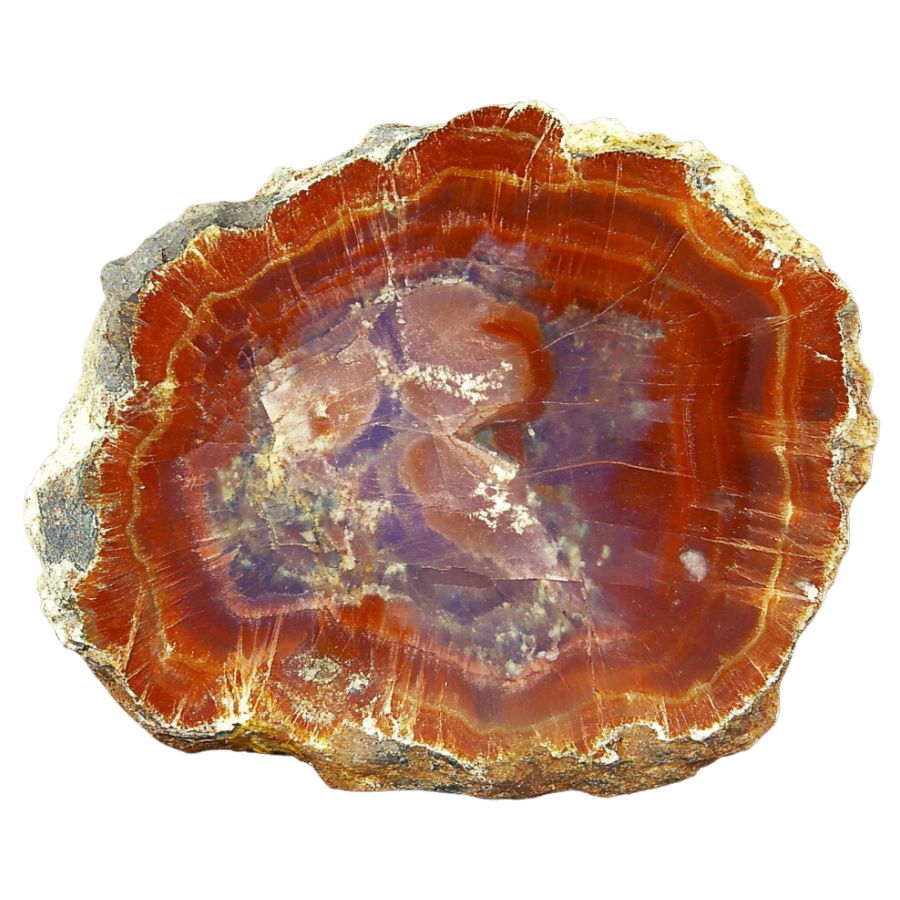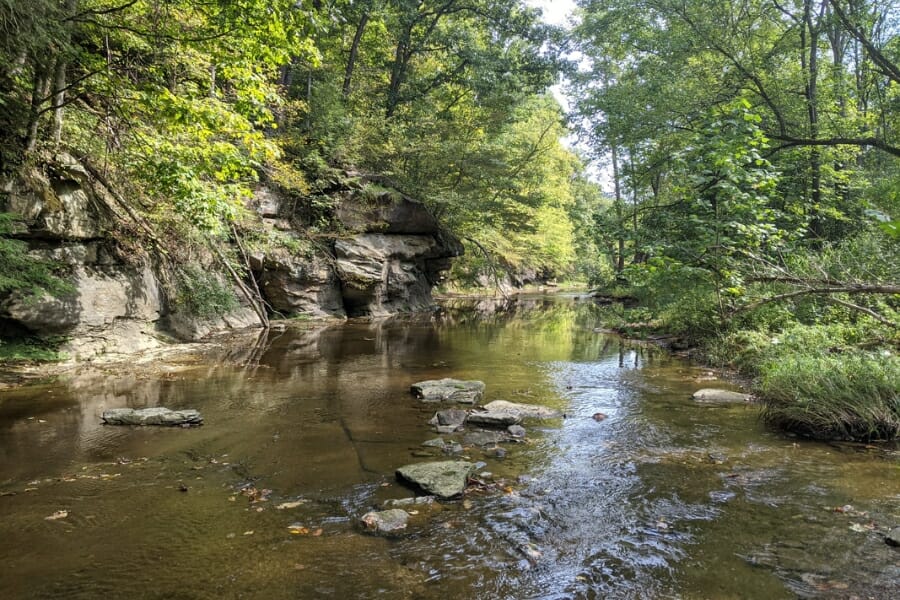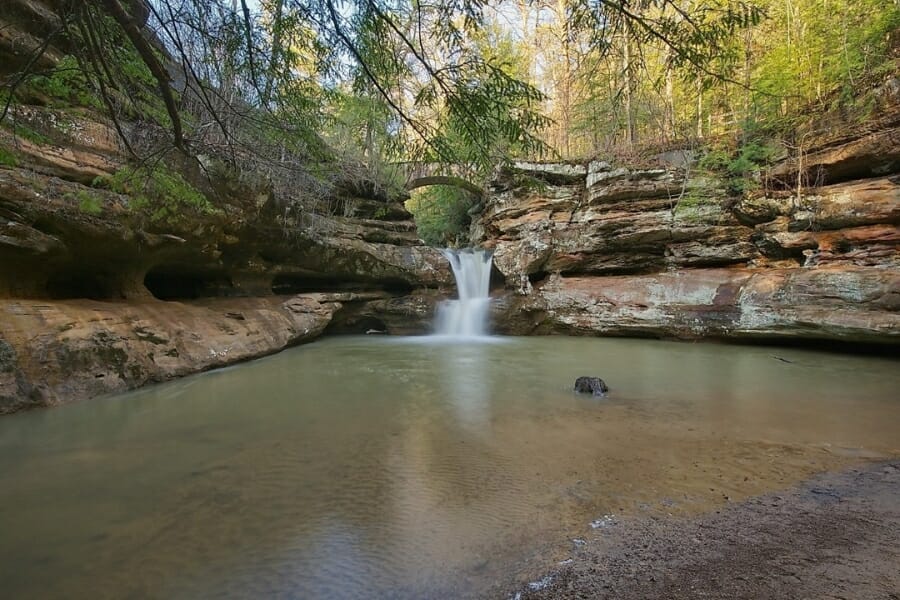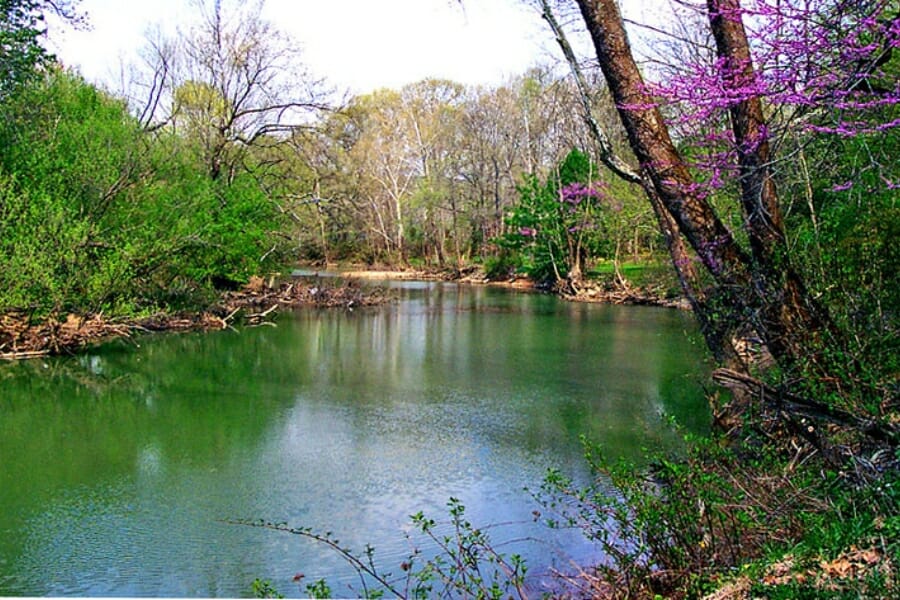Exploring the state’s rugged terrain offers a unique opportunity to discover petrified wood, a fossilized treasure from ancient forests. With the right tips, you’ll be ready to embark on your own adventure and uncover these fascinating remnants of prehistoric life.
Knowing where to look and what to expect will increase your chances of spotting these remarkable pieces scattered across this great state’s terrain!
Petrified wood you can find in the US
In the United States, several types of petrified wood can be found, each with unique characteristics based on the original tree species and the minerals involved in the fossilization process. Here are some of the types you’ll be able to find.
Araucarioxylon

Found in the Petrified Forest National Park in Arizona, this is one of the most famous types of petrified wood. It comes from an extinct species of conifer. As Arizona’s state fossil, Araucarioxylon holds a special place in the state’s natural history.
These trees once formed vast forests during the Late Triassic period, about 225 million years ago. The vibrant colors in this petrified wood come from minerals that replaced the original tree material over time.
Metasequoia

Often referred to as dawn redwood, this type of petrified wood can be found in various parts of the U.S., including the Pacific Northwest. Metasequoia was once thought to be extinct until living trees were later discovered in China.
Furthermore, its fine grain and reddish-brown color are characteristic features.
Palmoxylon

This petrified wood originates from palm trees and is often found in the Gulf Coast states like Texas and Louisiana. Recognized as the state stone of Texas, Palmoxylon is abundant and holds cultural significance.
The wood’s unique speckled or dotted pattern comes from the vascular bundles of the original palm tree. These fossils date back to the Cretaceous period, when the area was tropical and teeming with life.
Taxodium

Also known as bald cypress, this petrified wood can be found in the southeastern U.S., particularly in areas that were once swampy. Taxodium wood is often found in places that were ancient swamps, where these trees thrived millions of years ago.
The wood is durable and shows intricate grain patterns, with growth rings and knotholes that tell the story of its long history. It’s a fascinating glimpse into the wet environments that once dominated the Southeast.
Sequoioxylon

Petrified wood from ancient sequoia trees, found in places like California, where sequoia forests once thrived. These trees are the ancestors of the giant sequoias that still stand in California today.
The petrified wood is notable for its large, straight grain and reddish color, reflecting the immense size and age of the original trees.
Ginkgoxylon

Petrified wood from ancient ginkgo trees, which can sometimes be found in states like Oregon and Washington. Ginkgo is one of the oldest tree species on Earth, with fossils dating back over 200 million years.
Ginkgo petrified wood often has a light color and may show patterns similar to the fan-shaped leaves of the living ginkgo.
Dicotyledonous Wood

Found across various states, this type of petrified wood comes from broadleaf trees, making it more common and varied in appearance. You can spot dicotyledonous wood by the distinct vessels and growth rings that indicate seasonal changes.
This type of petrified wood is often found in regions that were once temperate forests, offering clues about the diverse plant life that existed millions of years ago.
Piceoxylon

Petrified wood from ancient spruce trees, commonly found in areas like Wyoming and Montana, where coniferous forests once thrived. Piceoxylon is known for its straight grain and pale color, often showing growth rings that tell the tree’s life story.
These trees were part of the ancient boreal forests that covered large parts of North America during cooler periods.
A Quick Request About Collecting
Always Confirm Access and Collection Rules!
Before heading out to any of the locations on our list you need to confirm access requirements and collection rules for both public and private locations directly with the location. We haven’t personally verified every location and the access requirements and collection rules often change without notice.
Many of the locations we mention will not allow collecting but are still great places for those who love to find beautiful rocks and minerals in the wild without keeping them. We also can’t guarantee you will find anything in these locations since they are constantly changing.
Always get updated information directly from the source ahead of time to ensure responsible rockhounding. If you want even more current options it’s always a good idea to contact local rock and mineral clubs and groups
What Rough Petrified Wood Looks Like
Most of the photos you find of petrified wood are pieces that have been cut and polished. That is certainly useful but isn’t super helpful once you are out in the field. This is what you should look out for once you start hunting:
Exteriors like this

Every type of petrified wood has a different exterior and pattern but this is a good starting point on what to look for.
Texture and grain patterns

One of the most distinctive features to look for is the texture and grain patterns. Petrified wood often retains the original structure of the tree, including the grain, knots, and even growth rings. These patterns can appear similar to modern wood but are typically more rigid and fossilized.
Examine the surface for any linear patterns or striations that indicate the original wood grain. The texture may feel smoother or more polished in certain areas where mineralization has created a glassy effect.
Coloration and mineralization

The color of petrified wood can vary significantly due to the minerals that replaced the organic material during the fossilization process. Common colors include shades of brown, red, yellow, orange, and black.
Some pieces might even exhibit multiple colors in intricate patterns. These colors are often more vivid and diverse than those found in regular rocks. When inspecting potential petrified wood, look for these distinct and varied hues, which can indicate the presence of different minerals such as silica, iron, manganese, and others that contributed to the petrification process.
Bark and exterior features

Another telltale sign of petrified wood is the presence of bark impressions or external textures that resemble tree bark. These features are often well-preserved and can include the rough, fibrous texture of bark, knots, or other surface irregularities typical of natural wood.
The exterior of rough petrified wood may also have a weathered appearance, with cracks and fractures that occurred as the wood fossilized over millions of years. Look closely for these natural wood features, as they can be a strong indicator that you have found a piece of petrified wood.
Weight and density

Petrified wood is typically much heavier and denser than regular wood due to the mineralization process. When rockhounding, pick up the specimen to feel its weight. Even small pieces of petrified wood will feel significantly heavier than an equivalent-sized piece of non-fossilized wood.
This increased density is due to the replacement of organic material with minerals, making petrified wood feel more like a rock than wood. Comparing the weight and density of your find with known samples of petrified wood can help confirm its authenticity.
- The extensive local experience of our team
- Input from a variety of local rockhounds and rockhound groups
- The difficulty in accessing a location
- Safety and potential hazards when collecting
- Private and public locations
- A desire to include locations for both the experienced and newbie hunters who are just starting out
Using these inputs we think we’ve put together the best list out there for those who love finding petrified wood for our collections!
General Areas To Try First

Before we get into the specific places you should be looking we wanted to give you some more general advice. Once you get to your hunting area you should head straight for these areas if you want to have the best results:
Lakeshores

Lakeshores are like natural garbage cans because all things wash up and get left there over time. That includes wood that has turned to stone. As the water rises and falls, it carries sediment and rocks. It also takes the fossilized remains of trees from long ago.
Most lakeshores have a variety of rocks and minerals, which makes them an excellent place for petrified wood to grow and thrive. You’ll find a nice mix of sedimentary and volcanic rocks, the best sites for preserving wood fossils.
Roadcuts

When building roads, parts of the ground are often cut away to make a smooth path. The magic happens when the road cuts through layers of rock and soil. Petrified wood is often buried deep underground, and roadcuts let us see these underground wonders.
As workers blast through the rock layers, they accidentally find petrified wood that has been there for hundreds of years. Petrified wood is easy for collectors to spot because the exposed rock layers of roadcuts make it easy to see its unique patterns and colors.
Streams and creeks

Streams and creeks can move loose sediment away, which can reveal old wood that has turned to stone. As the water moves around, it exposes small pieces or even more significant amounts of petrified wood that have settled on the streambed.
Streams and creeks are more accessible for collectors because they are not as big. You can easily walk along their banks, jump from rock to rock, and look for petrified wood at the water’s edge.
River beds

Riverbeds are excellent for finding petrified wood due to their unique geological and environmental conditions. Rapid burial by sediments like sand, silt, and mud protects fallen trees from decay, initiating the fossilization process.
Mineral-rich waters flowing through rivers facilitate the replacement of organic material with minerals such as silica, turning wood into stone. Over time, erosion exposes these buried treasures, making them accessible for discovery.
This dynamic environment, with constant sediment deposition and mineral infiltration, creates ideal conditions for the formation and eventual exposure of petrified wood.
DON'T MISS OUT ON ANY GREAT FINDS!
While you're out searching for Petrified Wood you're going to find A LOT of other interesting rocks and minerals along the way. The last thing you want to do is toss out something really interesting or valuable. It can be easy to misidentify things without a little guidance.
We've put together a fantastic field guide that makes identifying 140 of the most interesting and valuable rocks and minerals you will find REALLY EASY. It's simple to use, really durable, and will allow you to identify just about any rock and mineral you come across. Make sure you bring it along on your hunt!
The Best Places To Find Petrified Wood In Ohio
Here are the best places to find petrified wood in the state. Although there are many more locations you can go rockhounding in Ohio, you can also try to do it to find more petrified wood.
Always Confirm Access and Collection Rules!
Before heading out to any of the locations on our list you need to confirm access requirements and collection rules for both public and private locations directly with the location. We haven’t personally verified every location and the access requirements and collection rules often change without notice.
Many of the locations we mention will not allow collecting but are still great places for those who love to find beautiful rocks and minerals in the wild without keeping them. We also can’t guarantee you will find anything in these locations since they are constantly changing.
Always get updated information directly from the source ahead of time to ensure responsible rockhounding. If you want even more current options it’s always a good idea to contact local rock and mineral clubs and groups
Captina Creek

Captina Creek has cut through many different rock types, revealing layers of Ohio’s ancient history. In terms of geography, it flows through hilly areas and lush valleys that show how erosion has changed the land over thousands of years.
Under its banks are layers of sedimentary rock, which are the remains of old seas and rivers. There are a lot of fossils in these rock formations, including the highly sought-after petrified wood. The creek’s exposed rocks and eroded banks make it a great place to find these old wooden treasures.
Captina Creek is a great place for people with a sharp eye and a little bit of patience to know about Ohio’s early history. Every find along its banks is a link to the paat, making it a must-see for anyone who wants to learn more about the natural wonders of the Buckeye State.
Where we found petrified wood at Captina Creek
The action of the water eroding the banks and bedrock can reveal petrified wood that’s been buried for millions of years. Looking in the gravel and among larger rocks can sometimes yield petrified specimens.
Heavy rainfall can wash out new material from the banks and surrounding areas, bringing hidden treasures to the surface.
Before bringing home all the petrified wood you found in Ohio, make sure you know the state’s recent rules for collecting.
Middle Branch Shade River

Middle Branch Shade River is an interesting place where geology, geography, and history all come together. This waterway, which is surrounded by rolling hills and green forests, shows how the area was shaped by geological events that happened long ago.
Its path goes through layers of sedimentary rock, which are left over from times when there were big seas and active river systems. Rocky outcrops, sandy shores, and eroded banks give clues about the river’s geological history. Because of these things, it is a good place to look for petrified wood.
Every sand grain, rock, and piece of petrified wood found here is a reminder of the area’s long and interesting history, which makes it a great place to go on an exploratory trip.
Where we found petrified wood at Middle Branch Shade River
Rain can wash materials, like petrified wood, away from the banks and areas upstream. If you search after these things, you might be more likely to find specimens.
Sifting through the gravel and examining larger rocks along the banks of the river can also be fruitful.
Muskingum River

One of Ohio’s most famous rivers, the Muskingum, winds through the state’s many different landscapes, showing how geologically and geographically rich the area is. The Muskingum starts where the Walhonding and Tuscarawas rivers meet.
As it flows, it shows Ohio’s ancient sedimentary rock formations, which are reminders of a time when there were seas and dense forests. The river’s landscape is made up of lush valleys, steep bluffs, and large floodplains.
It flows through a large area. Because of this varied landscape and the river’s constant erosion, layers of rock and sediment can be seen. Geologists and curious explorers alike are drawn to the Muskingum River by its natural beauty and the chance to find petrified treasures.
Where we found petrified wood at Muskingum River
Check out the riverbanks, especially where erosion has revealed deeper layers of rock and sediment. There may be petrified wood buried in these places.
On the river’s gravel bars, which are made up of rocks and other debris carried downstream, pieces of petrified wood could be left behind.
Raccoon Creek

Raccoon Creek flows through a variety of landscapes and tells stories about the area’s geological history.
The creek’s source is in the middle of the state, and as it flows through layers of sedimentary rock, it takes you on a magical trip through time, giving you a sense of ancient seas and ancient forests.
The creek’s constant erosion and the geology of the area have revealed treasures from long ago, like the highly sought-after petrified wood. As sediment covered forests in the past, mineral-rich waters began to change, turning organic wood into stone that will last forever.
Where we found petrified wood at the Raccoon Creek
Eroded banks or any exposed rocky outcrops can sometimes reveal petrified wood or other fossils. Look closely at areas where different layers of sediment are visible.
You should also check gravel bars or areas with accumulated stones. These are often repositories for a mix of materials carried downstream, including potential petrified wood fragments.
Sunfish Creek

Sunfish Creek flows gracefully through many different landscapes and serves as a sentinel for the state’s interesting geological stories. The creek starts its journey in the gentle uplands and flows through sedimentary formations.
It’s surrounded by a beautiful mix of rolling hills, green valleys, and sometimes limestone cliffs. This changing landscape, which has been shaped by natural forces over thousands of years, shows off a rich tapestry of rocks and sediments.
A trip to its banks will not only be peaceful, but it will also give you the chance to touch and see pieces of Earth’s rich history.
Where we found petrified wood at Sunfish Creek
Areas where the creek deposits accumulated stones, sediments, and other materials can be promising. Petrified wood fragments could be nestled among the gravels.
Check out any eroded banks or exposed rock along the creek as a starting point. Petrified wood or other interesting fossils can sometimes be found in these places.
Other Great Places To Find Ohio Petrified Wood

After telling you where you can find the best petrified wood in Ohio, we can tell you where else you can find great examples. For ease of use, we put them in order by county.
| County | Location |
| Athens | Coates Run |
| Athens | Federal Creek |
| Athens | Long Run |
| Athens | Rock Riffle Run |
| Gallia | Campaign Creek |
| Meigs | Leading Creek |
| New Concord | North Crooked Creek |
Common Questions About Finding Petrified Wood In Ohio

The following frequently asked questions about petrified wood in Ohio should be addressed.
How old is petrified wood in Ohio?
Most of the petrified wood in Ohio is from the Carboniferous Period, which lasted from about 359 million years ago to 299 million years ago. During this time, the area that is now Ohio was mostly swamps and forests.
When plants and trees in these places died, sediments quickly covered them up. This quick burial stopped the normal decay and made it possible for the bones to turn to stone.
Can you find petrified palm wood in Ohio?
Petrified palm wood is not typically associated with Ohio. The state’s geologic history and the age of its rock formations don’t coincide with the time when palm trees would have been prevalent in the region.
The Best Places To Buy Petrified Wood In Ohio

People don’t always want to spend the whole day outside looking for petrified wood. Sometimes you just want to add something new to your collection or give it to someone as a gift. Here are some rock shops in Ohio where you can buy petrified wood:
- Dysart Woods Park – 61961 Dysart Woods Rd, Belmont, OH 43718
- Fossil Park – 5705 Centennial Rd, Sylvania, OH 43560
- GeoRarities Rock Shop – 2511 Essex Pl, Cincinnati, OH 45206
- Johnson Woods State Nature Preserve – 13240 Fox Lake Rd, Marshallville, OH 44645
- Perry’s Pebbles – 4112 Lisa Ln, Middletown, OH 45042



